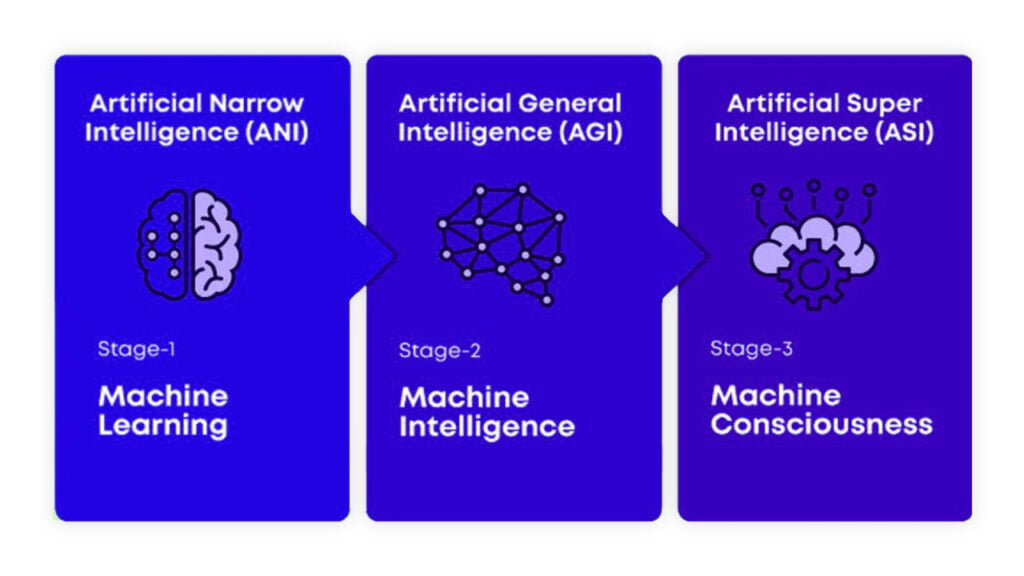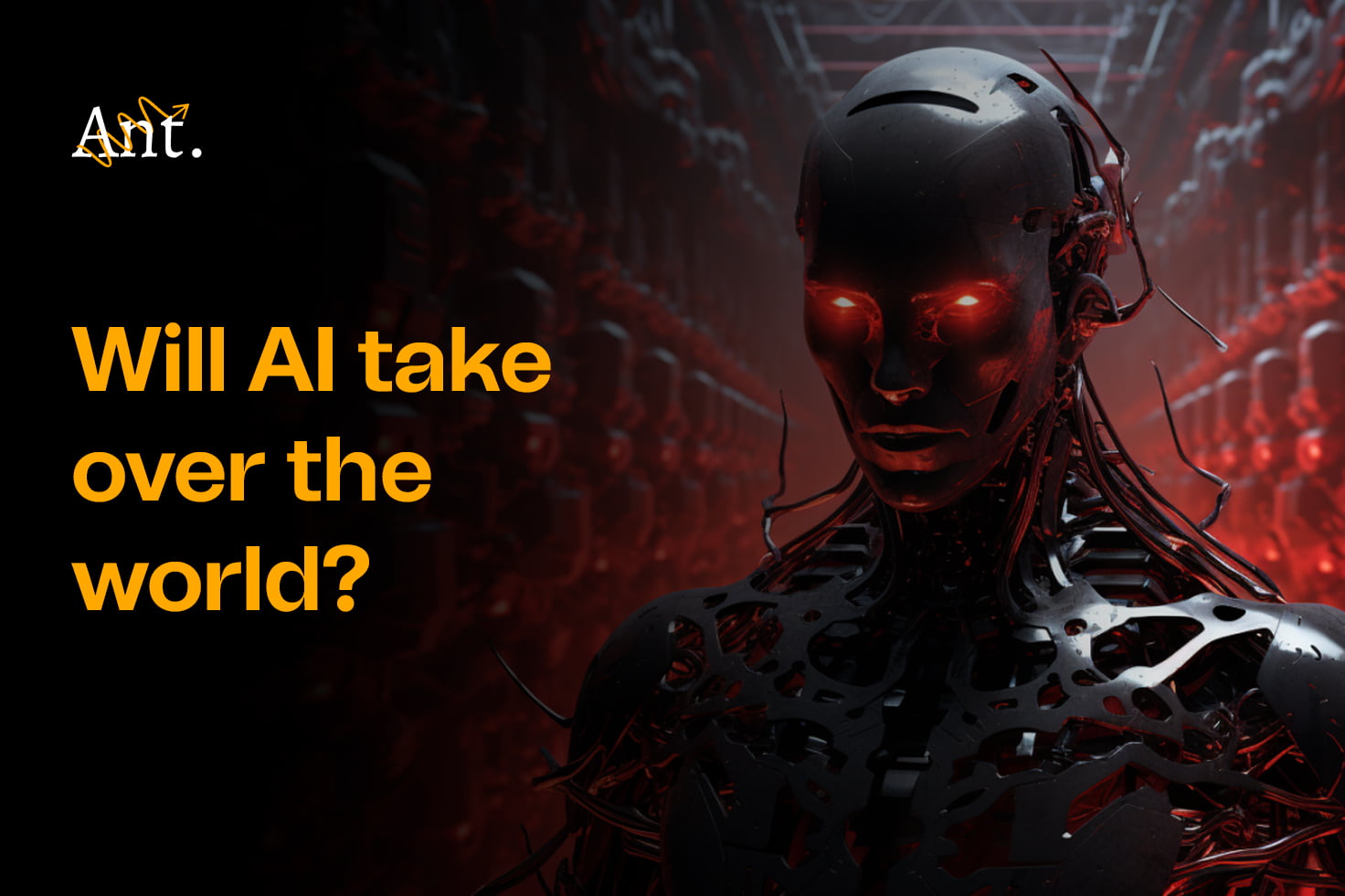Science fiction movies like The Terminator and The Matrix show that AI becomes self-aware and launches a nuclear attack on humanity.
After ChatGPT the craze of Artificial Intelligence has spread like hell to anywhere in the tech world, ChatGPT has gained 1M users in just 5 days, and after that many new AI companies emerged, all aiming to develop AI technologies to help people with AI tools.

As AI has replaced a bunch of repetitive or creative tasks people are worried about AI and think “Will AI actually take over humanity?”
After research, I found experts say that AI is not a villain like in science fiction movies.
In short, no, AI will not take over the world. It’s designed to help us enhance human capabilities, and productivity and bring new opportunities, not replace humans.
Current Stage of AI – How Smart is AI Today?
The concept of artificial intelligence began in 1941 with the development of the first digital computers. The field officially launched in 1956, but by the 1970s, it hit its first major setback due to overhyped expectations and underwhelming results.
The 2010s were game-changing, deep learning, and machine learning making AI smart in recognizing what we say and see.

The Current Stage of AI is Artificial Narrow Intelligence (ANI) also known as Machine Learning. ANI systems are designed to do specific tasks we interact with in our daily lives.
Real Examples of ANI are Siri, Alexa, and Google Assistant.
The Future of Artificial Intelligence – Experts categorize AI progress into stages:
- Artificial Narrow Intelligence (Machine Learning)
- Artificial General Intelligence (Machine Intelligence)
- Artificial Super Intelligence (Machine Conscious)
The Limits of AI – What AI Can’t Do (Yet)
Meredith Broussard, a data scientist and professor at New York University, argues that we often misuse AI for social problems. She emphasizes that AI relies on the data it’s trained on, which can lead to biases if the data itself is biased.
While AI has become impressive and intelligent, it still has limitations. Here are some things AI struggles with to do:
Understanding emotions
AI can recognize emotions in faces or text, but it doesn’t truly understand them. This limits its ability to interact with humans on a deeper level. Maybe in the future AI get this power as well.
Common sense
AI can process and research information deeply, but it lacks the real-world understanding humans have. It might struggle with situations requiring common sense or adapting to unexpected circumstances.
Creativity and innovation
AI is an expert at following patterns and completing tasks, but it isn’t great at coming up with truly original ideas or concepts. It can’t explain its reasoning or decisions in a way that humans always find satisfactory.
Trustworthiness:
Recently Google launched its AGI for short answers to search queries, but people are ignoring it because we don’t want to take (health and travel, etc) advice from an emotinless AI bot. People won’t trust the AI bot instead they go with blogs that are human written. Even when good AI models exist, creating an inherently trustworthy AI can be challenging due to fundamental limits in mathematics and algorithm design.
Broussard highlights the importance of careful implementation and human oversight when using AI for complex tasks.
Will AI Take Over Humanity? – Myth vs Reality
The idea of super-intelligent robots taking over the world is a popular theme in science fiction, but actually, does it make sense?

A survey of 2,700 AI experts revealed that a majority of people believe there is at least a 5% chance that superintelligent machines could pose a threat to humanity. Some researchers have signed an open letter urging for a pause in AI development and stronger regulation due to potential profound risks.
While there is no consensus among experts, there is a clear call for careful consideration, ethical guidelines, and regulation to ensure that AI develops in a way that is beneficial and not harmful to humanity.
What is NEURALINK – The Biggest Threat to Humanity?
Neuralink is a neurotechnology company founded by Elon Musk, aiming to develop brain-machine interfaces (BMIs) that connect the human brain directly to computers.
Neuralink aims to develop implants that can interface with the human brain. The potential applications are vast. For instance, Restoring lost function and Augmenting human capabilities.

That’s an amazing technology, but it’s a digital device so it can be hacked by someone, If it gets hacked by hackers, they can put some virus in it. As the United Nations warns, Neuralink is an AI brain implant that will hack your head.
While Neuralink’s technology could offer significant benefits to humans in the future, particularly for individuals with disabilities, the broader implications of such advancements are complex and require careful consideration and regulation to ensure they do not pose a threat to humanity.
Real Risks of AI on Humanity
While a robot takeover might be far-fetched, there are potential risks to consider:
- Job displacement: We think AI just can replace automative tasks jobs but AI can replace creative jobs like Art Design, Images, music composers, graphics designers, etc, and some jobs might disappear completely as we have seen in history.
- Bias and discrimination: AI systems trained on biased data can perpetuate those biases in real-world applications.
- Weaponization of AI: The use of AI in autonomous weapons raises ethical concerns.
- Political Propaganda: AI can create realistic-looking articles, social media posts, and even videos that spread misinformation. These can be used to slander opponents or manipulate public opinion.


